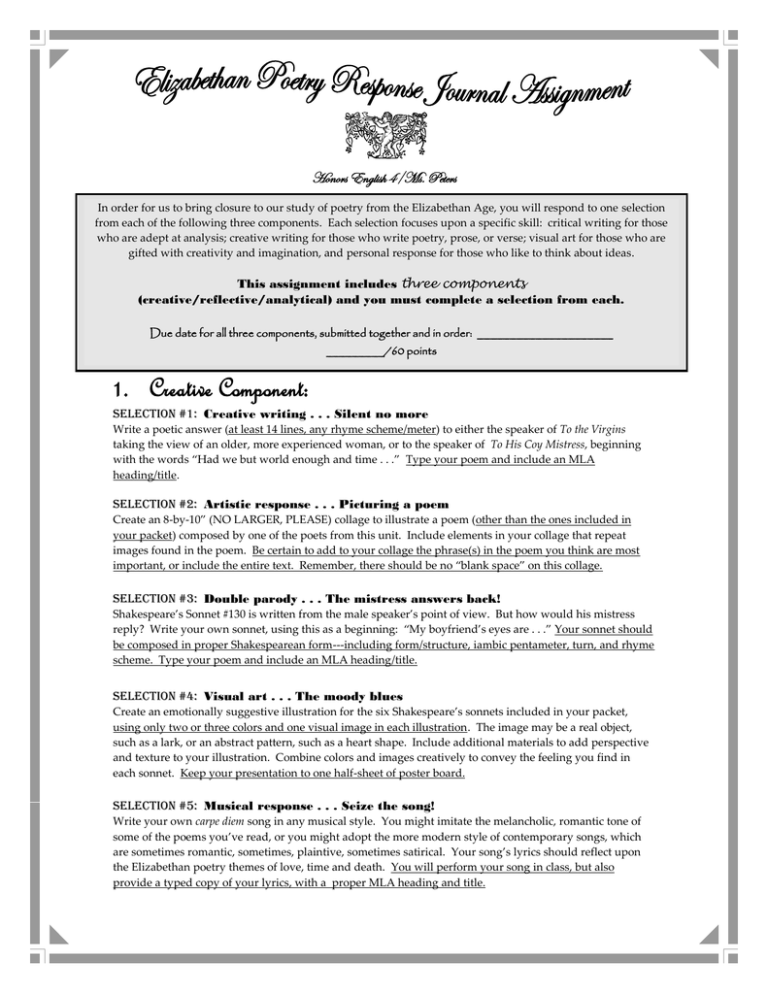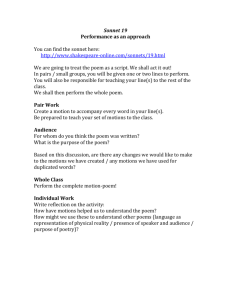Elizabethan Poetry Journal Response Assignment
advertisement

Honors English 4/Ms. Peters In order for us to bring closure to our study of poetry from the Elizabethan Age, you will respond to one selection from each of the following three components. Each selection focuses upon a specific skill: critical writing for those who are adept at analysis; creative writing for those who write poetry, prose, or verse; visual art for those who are gifted with creativity and imagination, and personal response for those who like to think about ideas. This assignment includes three components (creative/reflective/analytical) and you must complete a selection from each. Due date for all three components, submitted together and in order: _____________________ _________/60 points 1. Creative Component: Selection #1: Creative writing . . . Silent no more Write a poetic answer (at least 14 lines, any rhyme scheme/meter) to either the speaker of To the Virgins taking the view of an older, more experienced woman, or to the speaker of To His Coy Mistress, beginning with the words “Had we but world enough and time . . .” Type your poem and include an MLA heading/title. Selection #2: Artistic response . . . Picturing a poem Create an 8-by-10” (NO LARGER, PLEASE) collage to illustrate a poem (other than the ones included in your packet) composed by one of the poets from this unit. Include elements in your collage that repeat images found in the poem. Be certain to add to your collage the phrase(s) in the poem you think are most important, or include the entire text. Remember, there should be no “blank space” on this collage. Selection #3: Double parody . . . The mistress answers back! Shakespeare’s Sonnet #130 is written from the male speaker’s point of view. But how would his mistress reply? Write your own sonnet, using this as a beginning: “My boyfriend’s eyes are . . .” Your sonnet should be composed in proper Shakespearean form---including form/structure, iambic pentameter, turn, and rhyme scheme. Type your poem and include an MLA heading/title. Selection #4: Visual art . . . The moody blues Create an emotionally suggestive illustration for the six Shakespeare’s sonnets included in your packet, using only two or three colors and one visual image in each illustration. The image may be a real object, such as a lark, or an abstract pattern, such as a heart shape. Include additional materials to add perspective and texture to your illustration. Combine colors and images creatively to convey the feeling you find in each sonnet. Keep your presentation to one half-sheet of poster board. Selection #5: Musical response . . . Seize the song! Write your own carpe diem song in any musical style. You might imitate the melancholic, romantic tone of some of the poems you’ve read, or you might adopt the more modern style of contemporary songs, which are sometimes romantic, sometimes, plaintive, sometimes satirical. Your song’s lyrics should reflect upon the Elizabethan poetry themes of love, time and death. You will perform your song in class, but also provide a typed copy of your lyrics, with a proper MLA heading and title. 2. Reflective Component: Selection #1: Personal response Choose a line/stanza/section of one of the poem that we have read/will read in your Elizabethan Poetry packet. Reflect on why you have chosen this line/stanza/section: Does it incite a memory? An experience? A concern or fear? Reflect upon your personal reaction to the part of the poem you have chosen; response should be at least one double-spaced page with an MLA heading. Selection #2: Letter of gratitude Nor shall Death brag thou wander'st in his shade, When in eternal lines to time thou grow'st; So long as men can breathe or eyes can see, So long lives this, and this gives life to thee. In the following lines from Shakespeare’s sonnet #18, he claims that words/poetry (“eternal lines”) can be used to show appreciation for another person’s beauty and character. Select a person who is worth of your appreciation and thanks. Write a letter to that person, addressing and praising him/her for his/her character and actions---such as that person’s generosity, encouragement, kindheartedness, or caring demeanor. This selection provides you with an opportunity to show gratitude by use of the written word; response should be at least one double-spaced page with an MLA heading. Selection #3: What makes your heart ache? Love can bring great joy---and great sorrow. Poets probably lament the heartache of love---for one’s significant other, one’s family, for one’s friends and pets and fellow human beings---as much as they extol its pleasures. Describe a time when a relationship (not necessarily a romantic one) caused your heart to hurt. Reflect upon your personal reaction to the situation and what you were able to learn from the experience; response should be at least one double-spaced page with an MLA heading. Selection #4: “Love looks not with the eyes, but with the mind…” (Shakespeare) According to an old saying, “love is blind,” but to what extent is this maxim true? The thrill of falling in love can cloud one’s perceptions of a lover, but usually those clouds drift away over time. Is it possible to see a person’s faults clearly and still love him or her? Reflect upon your personal reaction to this statement and what you were able to learn from the experience; response should be at least one double-spaced page with an MLA heading. Selection #5: Woe is my life! Wishing me like to one more rich in hope, Featured like him, like him with friends possessed, Desiring this man’s art, and this man’s scope… Shakespeare claims that he sometimes envies others for different reasons, including their optimism, talent and ability to make friendships. Describe what talent/skill(s) you wish you possessed, that you see exemplified by others. Reflect upon your personal reaction to the situation and what you were able to learn from the experience; response should be at least one double-spaced page with an MLA heading. 3. Analytical Component: Select one of Shakespeare’s sonnets that is not included in your packet. Read the sonnet carefully. In your response, you should analyze the poem’s message and explicate its style, as well as discuss your reaction to the poem. What did you like/dislike about it? What questions do you have about the poem, and does the poem provide sufficient answers for those questions? Include the number of the sonnet in your response, which should be at least one double-spaced page with an MLA heading.




